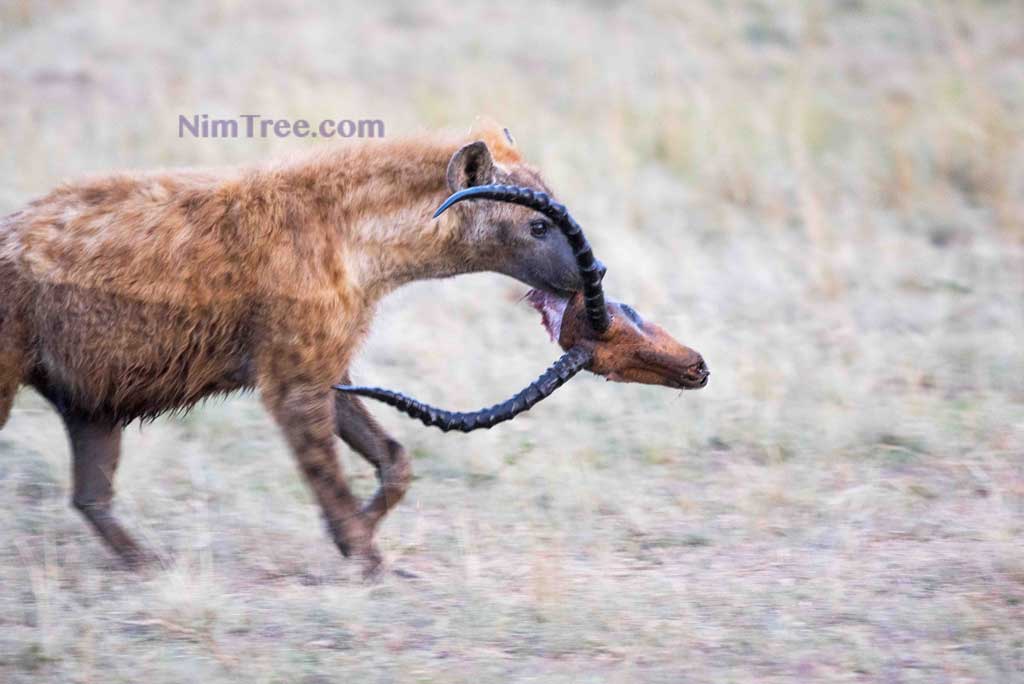Hyena Carrying Head of a Springbok on the planes of Masai Mara

As mentioned in my last post about being prepared and ready to shoot, I would like to present the image I was talking about.
At one point, every wildlife photographer dreams of photographing beautiful wildlife of Africa. The action packed drama which unfolds in front of your own eyes is out of this world.
Survival of the fittest can be witnessed all over the place in Masai Mara.
In nature, nobody can predict what would happen next and we need to be prepared to capture such unexpected moments. As a tourist, all one needs to do it stay awake during game drives and look where the actions is taking place. However, as a wildlife photographer, it takes some preparation and high level of alertness to capture these moments. The reason being, moments like these which take place in the wild, are not staged, we can not request the animal for a repeat performance. Moreover, pre-planning helps us to reduce time required to take the image which can be very critical. Some moments only last for few seconds in the wild. I still remember, few decades ago, my first tiger sighting in the wild only lasted 39 seconds in the winter month of December.
39 seconds may not sound much in real life, however if you are a prepared wildlife photographer, its more than enough time on a game-drive to take decent keeper images of wild animals in action.
If we consider a moderate 7 FPS camera, and discount 2 frames for buffer related issues, we are left with 5 FPS for 39 seconds. For the sake of simplicity, lets call it 30 seconds sighing.
So, 30 Seconds X 5 FPS =150 images. Lets be generous here and say 50 of the images were out of focus, had too much vegetation and with unpleasing composition, we are still left with about 100 images after a sighting which did not even last a full minute. Out of these 100 images, 1 or two can be keeper images, rest can be discarded or archived for record keeping purposes.
All this is only possible when
a) We have the camera in hand, ready to shoot
b) Lens cap is not ON
c) Camera is not kept in a bag
d) Photographer is alert during safari
e) Photographer is competent enough to focus quickly on the eye of the animal.
f) Lens is NOT hunting for focus
g) Vehicle is stationary and the engine is switched off (even the engine vibration can cause shake in your photos and sharpness will go down)
i) Your co-passengers are not moving too much. There will be some excitement and people will get up to get a glimpse of the animals and you will feel it, so be prepared and take support from a bean bag.
j) The camera is pre-set at adequate level of ISO, even before spotting the animal.
Lets come back to this photograph for a moment. Is this the most beautiful image of a Hyena? No, its not. Is it perfectly sharp ? No, its not. Then why do i like it?
This image is not about picture quality, this image is about capturing and recording the moment. There were 4 photographers in the same vehicle (including myself) and one of them is winner of Wildlife photographer of the year competition, BUT Only I have this image. Others had their cameras in the bag, so by the time they could take it out, the hyena was long gone in to the safety of grass. This is not about being genius, its about being alert and planning ahead.
Every night, when I take a backup of my camera during safaris, I set my camera to Manual mode, with widest aperture and about 3200 ISO. This helps me next morning during sunrise, when the sun is still coming out and light is low, I am still prepared to get a decent image, if something is spotted during safari.
As the morning game drive progresses, with increasing light, I go on reducing my ISO. This gives me full control and that’s how early morning Hyena with Springbok’s head was captured.
If there are any questions, do let me know by filling up the contact form, I am happy to answer them.
Location: Masai Mara Game Reserve, Kenya
Camera : Nikon D850
Lens: Nikon 200-400mm F/4
Aperture: F/5.6
Shutter Speed : 1/400th Sec
ISO: 3200
Tripod / Flash: None